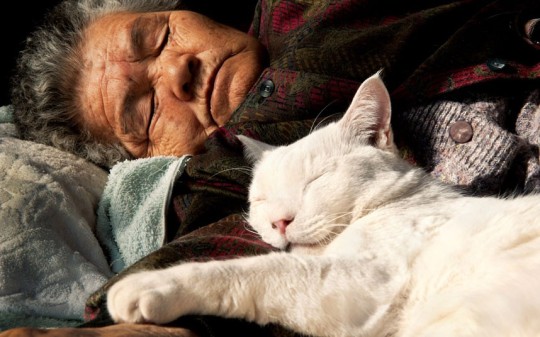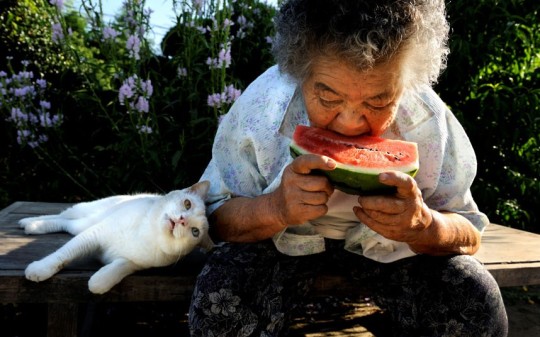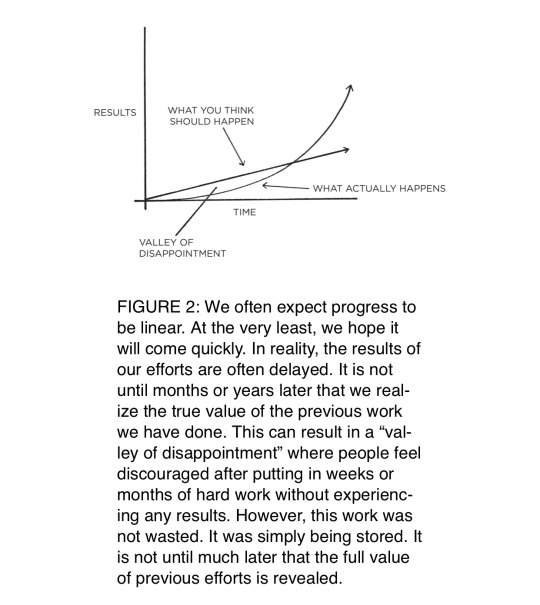Don't wanna be here? Send us removal request.
Text
Located on the Darss Peninsular, overlooking the southern coast of the Baltic Sea, is a log cabin, nestled among the jungle-like overgrowth of surrounding birch and willow trees. The cabin is Christian Loeffler's atelier, where he locks himself up to work on both his visual art und his music. In the centre of the room is a huge oak table, splotched with multicoloured oil paints, surrounded by canvases, cameras tripods, tools, brushes. There's a great view of the sea, and the wide patio windows allow the light to flood inside, casting shadows of the leaves and branches across the walls and onto the table. There's a small fireplace which allows him to work during the winter, so that he can continue his introspectiive creative process during the cold months too. The place is very basic – working, sleeping, cooking, all in one room; yet it's these modest and in some ways rudimentary parameters that allow Loeffler to make sincere and honest music, concentraing on just the essentials. 'Mare' is his second studio album and follows in a similar vein to his self-released debut, 2012's 'A Forest'. However a key difference is that while his first album was heavily sample-based, 'Mare' is much more organic, in which nearly every sound and every instrument is self-recorded. Many of the album's ideas are based on field-recordings taken from the surroundings. On top of this, several microphones were set up in the room ad left to run on for whole sessions. The microphones collected everything, from tapping, singing, playing, footsteps, as well as percussive elements added on the fly such as bottles, sticks, a set of keys, or basically anything that was lying around. Sometimes he would open the sliding patio doors, where sounds from outside would blend into the mix. Among the instruments placed around the table were an old marimba, a mandolin zither, some self-modified synthesizers, and various other sound tools accumulated from his travels. There are also four tracks that feature the vocals of previous collaborator Mohna ('Haul', 'Mare', 'Vind', 'Wilderness'). For Loeffler, another interesting aspect of the album is that it's the first time he himself sings on a record ('Lid', 'Pacific', 'Nil'). „The meaning was not intended to be essentially different to 'A Forest' but where the first album sometimes still felt to just be on the surface of what I can say with this project, it now feels like that I've come closer to the core of what I want to express.“ The instrumentation, the setting, and the process, make 'Mare' a highly individual body of work that sees him expanding the limits of his set-up. The LP features the highly emotive sound that Loeffler's become known for, using deep house as a stylistic framework with which to base his tracks. Exploring spaces of emotional and physical loss, getting lost, as well as arriving, he blends wistful melodies, drum machines, and found sound into a wandering, melancholic mélange.
http://www.christian-loeffler.net/
0 notes
Text
I no longer force things. what flows flows, what crashes, crashes. I only have space and energy for things that are meant for me.
185K notes
·
View notes
Text
dear you, focus on yourself focus on yourself focus on yourself focus on yourself focus on yourself focus on yourself focus on yourself.
218K notes
·
View notes
Photo









Nine years ago, Japanese photographer Miyoko Ihara began snapping pictures of the relationship between her grandmother and her odd-eyed white cat. Miyoko’s grandma Misao found the abandoned cat in a shed on her land and the pair have barely been apart since. Misao named the white cat “Fukumaru” in hope the “God of fuku (good fortune) comes and everything will be smoothed over like maru (circle)”. Fukumaru is always in Misao’s shadow whether she is farming her land, having a bath, eating or sleeping. Now nearly a decade later their friendship and adventures have been documented by Miyoko in a photo book called Misao the Big Mama and Fukumaru the Cat.
from the Telegraph
290K notes
·
View notes
Link
0 notes
Link
0 notes
Text
QUALITIES OF THE PROFESSIONAL
1. The professional shows up every day
2. The professional stays on the job all day
3. The professional is committed over the long haul
4. For the professional, the stakes are high and real
5. The professional is patient
6. The professional seeks order
7. The professional demystifies
8. The professional acts in the face of fear
9. The professional accepts no excuses
10. The professional plays it as it lays
11. The professional is prepared
12. The professional does not show off
13. The professional dedicates himself to mastering technique
14. The professional does not hesitate to ask for help
15. The professional does not take failure or success personally
16. The professional does not identify with his or her instrument
17. The professional endures adversity
18. The professional self-validates
19. The professional reinvents herself
20. The professional is recognized by other professionals
21. A PROFESSIONAL IS COURAGEOUS
22. THE PROFESSIONAL WILL NOT BE DISTRACTED
23. THE PROFESSIONAL IS RUTHLESS WITH HIMSELF
24. THE PROFESSIONAL HAS COMPASSION FOR HERSELF
25. THE PROFESSIONAL LIVES IN THE PRESENT
26. THE PROFESSIONAL DEFERS GRATIFICATION
27. THE PROFESSIONAL HELPS OTHERS
1 note
·
View note
Text
THE AMATEUR IS TERRIFIED
Fear is the primary color of the amateur’s interior world. Fear of failure, fear of success, fear of looking foolish, fear of under-achieving and fear of over-achieving, fear of poverty, fear of loneliness, fear of death.
But mostly what we all fear as amateurs is being excluded from the tribe, i.e., the gang, the posse, mother and father, family, nation, race, religion.
The amateur fears that if he turns pro and lives out his calling, he will have to live up to who he really is and what he is truly capable of.
The amateur is terrified that if the tribe should discover who he really is, he will be kicked out into the cold to die.
THE PROFESSIONAL IS TERRIFIED, TOO
The professional, by the way, is just as terrified as the amateur. In fact the professional may be more terrified because she is more acutely conscious of herself and of her interior universe.The difference lies in the way the professional acts in the face of fear.
HOW YOUR MIND CHANGES WHEN YOU TURN PRO
Turning pro is like kicking a drug habit or stopping drinking. It’s a decision, a decision to which we must re-commit every day. Twelve-step programs say ‘One Day at a Time.’ The professional says the same thing.
Each day, the professional understands, he will wake up facing the same demons, the same Resistance, the same self-sabotage, the same tendencies to shadow activities and amateurism that he has always faced.The difference is that now he will not yield to those temptations.He will have mastered them, and he will continue to master them.
THE NATURE OF EPIPHANIES
We usually think of breakthroughs as ecstatic moments that elevate us from a lower level to a higher. And they do. But there’s a paradox. In the moment, an epiphany feels like hell. Like Rosanne Cash’s dream, an epiphany trashes us. It exposes us and leaves us naked.
We see ourselves plain, and it’s not a pretty picture.
The essence of epiphanies is the stripping away of self-delusion. We thought we were X. Now suddenly we see we’re minus-X. We’re X divided by infinity.
There is great power in this moment.
We’ve lost something, yes. A cherished self-delusion must be abandoned, and this hurts. But what we have gained is the truth. Our bullshit falls away. The scales drop from our eyes. In that moment we have two options:
We can reconstitute our bullshit.
Or we can turn pro.
(Turning Pro, Steven Pressfield)
1 note
·
View note
Text
The pre-addictive individual (i.e., you and I when we’re young) experiences a calling. To art, to service, to honorable sacrifice. In other words, we experience positive aspiration. A vision of the higher, realized self we might become.The intimation of this calling is followed immediately by the apparition of Resistance.
Fear.
Self-doubt.
Self-sabotage.
What makes this moment so soul-precarious is that most of us are unconscious, in the event, of both our aspirations and our Resistance. We’re asleep. We know only that something is wrong and we don’t know how to fix it. We’re restless. We’re bored. We’re angry. We burn to accomplish something great, but we don’t know where to begin and, even if we did, we’d be so terrified that we still couldn’t take a step.
Enter: a drink, a lover, a habit.
Addiction replaces aspiration.
The quick fix wins out over the long, slow haul.
When we can’t stand the fear, the shame, and the self-reproach that we feel, we obliterate it with an addiction. The addiction becomes the shadow version, the evil twin of our calling to service or to art.That’s why addicts are so interesting and so boring at the same time.They’re interesting because they’re called to something - something new, something unique, something that we, watching, can’t wait to see them bring forth into manifestation.
At the same time, they’re boring because they never do the work.
Instead, the addict enacts his aspiration in shadow form. The addiction becomes his novel, his adventure, his great love. The work of art or service that might have been produced is replaced by the drama, conflict, and suffering of the addict’s crazy, haunted, shattered life.
(Turning Pro, Steven Pressfield)
1 note
·
View note
Text
A BRIEF HISTORY OF HARD WORK, ADJUSTED FOR RISK
“Your great-grandfather knew what it meant to work hard. He hauled hay all day long, making sure that the cows got fed. In Fast Food Nation (Houghton Mifflin, 2001), Eric Schlosser writes about a worker who ruptured his vertebrae, wrecked his hands, burned his lungs, and was eventually hit by a train as part of his fifteen-year career at a slaughterhouse. Now that’s hard work.
The meaning of hard work in a manual-labor economy was clear. Without the leverage of machines and organizations, working hard meant producing more. Producing more, of course, was the best way to feed your family. Those days are long gone. Most of us don’t use our bodies as though they are machines—unless we’re paying for the privilege and getting a workout at the gym. These days, 35 percent of the American workforce sits at a desk. Yes, we sit there a lot of hours, but the only heavy lifting that we’re likely to do involves putting a new water bottle on the cooler. So do you still think that you work hard? You could argue, “Hey, I work weekends and pull all-nighters. I start early and stay late. I’m always on, always connected with a BlackBerry. The FedEx guy knows which hotel to visit when I’m on vacation.” Sorry. Even if you’re a workaholic, you’re not working very hard at all. Sure, you’re working long, but today “long” and “hard” mean two different things. In the old days, we could measure how much grain someone harvested or how many pieces of steel he made. Hard work meant more work. But the past doesn’t necessarily lead to the future. Our future in the workplace is not about time at all. The future is about work that’s really and truly hard, not just time-consuming. It’s about the kind of work that requires us to push ourselves, not just punch the clock. Hard work is where our future job security, our financial profit, and our future joy lie. It’s hard work to make difficult emotional decisions, such as quitting a job and setting out on your own. It’s hard work to invent a new system, service, or process that’s remarkable. It’s hard work to tell your boss that he’s being intellectually and emotionally lazy. It’s hard work to tell senior management to abandon something that it has been doing for a long time in favor of a new and apparently risky alternative. It’s hard work to make good decisions with less than all of the data. It’s much easier to stand by and watch the company fade into oblivion. Today, working hard is about taking apparent risk. Not a crazy risk like betting the entire company on an untested product. No, an apparent risk: something that the competition (and your co-workers) believe is unsafe but that you realize is in fact far more conservative than sticking with the status quo. Richard Branson doesn’t work more hours than you do. Neither does Steve Ballmer or Carly Fiorina. Robyn Waters, the woman who revolutionized what Target sells—and helped the company trounce Kmart—probably worked fewer hours than you do in an average week. None of the people who are racking up amazing success stories and creating cool stuff are doing it just by working more hours than you are. And I hate to say it, but they’re not smarter than you either. They’re succeeding by doing hard work. As the economy plods along, many of us are choosing to take the easy way out. We’re going to work for the Man, letting him do all the hard work while we put in the long hours. We’re going back to the future, to a definition of work that embraces the grindstone. Some people (a precious few, so far) are realizing that this temporary recession is the best opportunity that they’ve ever had. They’re working harder than ever—mentally—and taking all sorts of emotional and personal risks that are bound to pay off. Hard work is about risk. It begins when you deal with the things that you’d rather not deal with: fear of failure, fear of standing out, fear of rejection. Hard work is about training yourself to leap over this barrier, tunnel under that barrier, drive through the other barrier and, after you’ve done that, to do it again the next day. The big insight: The riskier your (smart) co-worker’s hard work appears to be, the safer it really is. It’s the people having difficult conversations, inventing remarkable products, and pushing the envelope (and, perhaps, still going home at 5:00 P.M.) who are building a recession-proof future for themselves. So tomorrow, when you go to work, really sweat. Your time is worth the effort.”
(Seth Godin, Smart is the new Big)
1 note
·
View note
Text
fixing things
Salut. Sunt Elena, am 25 de ani și sunt ocupată să-mi construiesc imperiul. Spre deosebire de colegii de vârsta mea, încă prinși în dependența de Facebook, alegeri proaste legate de stilul de viață și a căror singură speranță este să ajungă angajați pe un salairiu de maxim 350 de euro, eu am vise mult mai mari și o viziune mult mai puternică de atât.

E mult mai ușor să vezi provocările mici (note la facultate, interviuri și aplicații pentru angajare, salarii) atunci când visele tale sunt mult mai mari și când știi că acestea sunt doar niște obstacole sau pași necesari pentru a ajunge la nivelul următor, nu obiective în sine.
Mi-a luat ceva timp până am ajuns aici: alegeri proaste, dependențe și obiceiuri neinspirate, multe atitudini toxice. Presupun așa arată, de fapt, pentru unii, drumul spre succes. A ajunge să-ți găsești calmul și centrul, a știi ceea ce vrei e un proces lung de învățare, de lupte cu demonii confortului și obișnuințelor. Eu știu mai bine decât oricine cum e să lupți cu procrastinarea, dependențele (tutun, Facebook, mâncat compulsiv și emoțional), lenea și continuă să fie o luptă și în prezent. Acum sunt doar mult mai concentrată pe o viziune măreață, ceea ce mă face să văd totul dintr-o altă perspectivă. Lucrurile mici, frustrările, impulsurile pier prin comparație, devin nesemnificative.

Așa că mă concentrez pe viziunea mea cea mare și nu o uit, indiferent cât de greu este drumul până la îndeplinirea ei și nu vreau, sub nicio formă, să permit obstacolelor mici, de zi cu zi, să devină mai importante sau să o deterioreze.
Fiecare zi este importantă pentru că reprezintă o parte a vieții. Fiecare zi reprezintă o nouă oportunitate de a clădi fundația spre a face ceea ce îți place, apoi spre a pune câte o cărămidă în realizarea sa, fără a uita însă să te bucuri de proces. Cartea lui Mihaly Csikszentmihalyi, Flow - The Psychology of Optimal Experience, mi-a schimbat complet percepția asupra vieții și a sensului ei. Am realizat că fiecare zi în care faci ceea ce îți place reprezintă, de fapt, scopul și sensul vieții tale și că fericirea constă tocmai în procesul de a face ceva, ci nu în destinația finală.

Cartea Mastery a lui George Leonard m-a mai învățat ceva remarcabil, și anume, că procesul devenirii are o altă formă decât linearitatea acelei săgeți ascendente pe care ne-o imaginăm cu toții. Procesul arată cam așa:


1 note
·
View note
Quote
Are you paralyzed with fear? That’s a good sign. Fear is good. Like self-doubt, fear is an indicator. Fear tells us what we have to do. Remember one rule of thumb: the more scared we are of a work or calling, the more sure we can be that we have to do it. Resistance is experienced as fear; the degree of fear equates to the strength of Resistance. Therefore the more fear we feel about a specific enterprise, the more certain we can be that that enterprise is important to us and to the growth of our soul. That’s why we feel so much Resistance. If it meant nothing to us, there’d be no Resistance.
Steven Pressfield (The War of Art: Break Through the Blocks & Win Your Inner Creative Battles)
1 note
·
View note
Text
“M-am întors în pădure pentru că am dorit să trăiesc pe îndelete, să mă confrunt doar cu realitățile esențiale ale vieții și să văd dacă nu cumva aș putea deprinde ce are a mă învăța, și nu, atunci când îmi va fi sosit ceasul, să descopăr că nu am trăit. Nu am dorit să trăiesc ceea ce nu era viață, trăitul e atât de prețios; nici nu am vrut să practic resemnarea, decât daca era chiar necesar. Am vrut să trăiesc adânc și să sug toata măduva din viață.” (Henry David Thoreau, Walden)

2 notes
·
View notes





